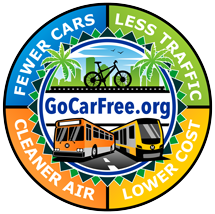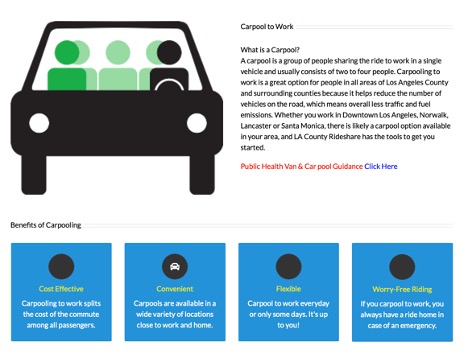
Lesson 11
Cost Splitting: Conquering Carpooling and Vanpooling

Above is a screenshot from Rideshare.LACounty.Gov that I think perfectly sums up the benefits of carpooling. It’s cost effective because the expenses are divided among multiple people. It’s also convenient and flexible, helps reduce traffic, and results in less air pollution and GHG emissions.
If three business professionals live in the same suburban neighborhood and work in the same downtown office tower, the American way is for each of them to drive their own car to work. So instead of combining their trips, they’ll pay three times as much for parking, burn three times as much gas, emit three times the pollution, take up three times the space on the highway, and spend three times more money than they need to.
Sadly, solo driving is a habit for the vast majority of commuters in this country. As I first mentioned in Lesson 5, according to the U.S. Census, 131,881,000 people commute to work by driving a car, truck, or SUV. And 90% of those people (117,967,000) drive one person per vehicle, or SOV (single occupant vehicle). There is a better, more efficient way that does not involve public transportation.
The Benefits of Carpooling
Carpooling had been undergoing a surge in popularity in 2019… but then the COVID pandemic hit. Fear of catching COVID made commuters reluctant to be in close proximity to others. Sadly, this caused many of the best carpooling apps and websites to either go dormant or shut down completely.
Now, in 2023, with high gas prices causing the cost of driving to surge, there is renewed interest in carpooling. Carpooling conserves gas, relieves stress, saves time, cuts parking costs, reduces air pollution, diminishes traffic jams, and saves money.
Another huge benefit of carpooling – for both driver and passenger – is that vehicles with more than one person onboard can use high-occupancy vehicle (HOV) lanes. This allows carpoolers to zip by solo drivers who are stuck in traffic. Using HOV lanes can cut a commute time in half in many cities.
“People are realizing that they can save thousands of dollars a year by carpooling. At the same time, they know that they’re helping to reduce our dependence on foreign oil and reducing greenhouse gas emissions by sharing the ride.”
– Steven S., Executive Director
Carpooling on the Web
Just as Airbnb.com created an efficient marketplace through a website, so too has the Internet helped people interested in carpooling. Websites like eRideShare.com, CarPoolConnect.com, CarPoolWorld.com, and Craigslist.com in the United States, and Poparide.com in Canada have online matching services for would-be carpoolers. As of 2023, CarPoolConnect has shut down.
Almost all carpool matching services are provided free of charge. Some cities have even started providing incentives to carpoolers, like gift certificates and prize drawings.
All you have to do is register at the website, then view the listings. Each listing states the city or town where the ride originates, the destination, days per week (such as “MTWTF”), and contact information for the person trying to organize the carpool. There is also a place for additional notes, such as the time each ride leaves in the morning.
Many carpool sites also have a section for long-distance carpools for out-of-town travel, and carpools specifically for running local errands. By the way, a car is not required; people without cars are invited to join and participate by sharing expenses.
Note that many carpool websites only serve a local or regional area. So do a Google search for your city plus carpool to see what organizations organize carpools in your area.
Safety
Most carpooling websites use anonymous email messaging to protect members’ identities until there is a match. When you correspond electronically with a prospective carpooler, that person does not know your name, address, or phone number.
Once you think you have a match, eRideShare.com recommends meeting in a public place before agreeing to carpool together. This is a good time to discuss specifics like eating and drinking in the car, as well as expenses and driving safety.
If you decide to carpool with this person, take a few precautions first. Photocopy and exchange copies of your driver’s licenses and a list of emergency contacts, as well as personal and employment references. Verifying where a person works and how long he’s worked there and calling references are good ways to put your mind at ease.
Also, copy down the car license plate number, make, and model. I even suggest photographing the driver and his car, just to be safe. Then make copies of all this information, including the photographs, and give it to a friend or coworker.
This may sound like a lot of precautions, but one can never be too careful. If you’re still unsure about your potential carpool partner, agree to a one-month trial period. Chances are your trepidation about riding with a stranger will be unfounded, and your carpool buddy will probably become a good friend.
Finding a Carpool the Old-Fashioned Way
If you’re not comfortable driving with a stranger you met through a carpooling website, you can look for a carpool the traditional way. Hanging up a flyer at work or at school is a good start. Ask around at the office or on campus to see if anyone lives in your part of town. Then ask people in your neighborhood if they know anyone who works near you.
Car Free Success Story:
The carpool that I started is among a group of friends. What we do is contact each other when we have a need to go to a particular store, like the farmers market, feed store, Trader Joe’s (supermarket), or garden supply store, and then several of us pile in a car and do our individual shopping. This has been a really fun way to get together with friends. We often talk about things that are going on around town and just generally catch up. Also the huge benefit now has been that we save money in gas and have several less cars on the road at peak shopping times! I suggest that people talk to their friends and find out where, when, and how often they go to the same stores. Start slow, and see how easy it gets from there.
Carpooling Tips
Here are a few carpooling tips from the Wisconsin Department of Transportation’s excellent website:
- Establish guidelines up front, so everyone in the carpool knows the expectations.
- Make sure the driver has proper auto insurance and that he notifies his insurance company that he is participating in a carpool.
- Decide when, how, and how often expenses will be paid to the driver.
- When splitting expenses, be sure to include parking costs.
- Be on time. Waiting for passengers who aren’t ready frustrates other carpool members and may even get you booted from the group.
- If you know you’re going to be late, call ahead and let the driver know. Maybe she can pick you up last.
- Agree on policies regarding eating in the car, smoking, radio stations, and so on.
- All parties should try to remain flexible to accommodate delays and minor emergencies.
- Establish backup plans for when the car breaks down or the driver is sick or takes a vacation.
- Maintain excellent hygiene and grooming habits.
- Avoid wearing cologne or perfume.
- Remember that some people prefer quiet time, especially in the morning.
- Avoid controversial topics of conversation.
- If you decide to leave the carpool, give your carpool partners a few weeks’ notice to make other arrangements. Ask them for the same courtesy.
Organized Ridesharing and Vanpooling
Many large metropolitan areas have structured vanpool or rideshare programs. Call your local Park and Ride office or your local public transit system to inquire. Or do a Google search by typing “[your city]”+“rideshare” or “[your city]”+“ridefinder.”
If you have five or more people going to the same place, you may qualify for a vanpool. This is a program where a local transit system provides a passenger van along a specified route in exchange for a reasonable monthly fare – usually between $70 and $100 per month per person. Vanpools are typically more structured than informal carpools. And vanpools work best with longer commutes, like twenty or thirty miles. One of the largest providers of vanpools is called Commute with Enterprise, part of Enterprise RentACar.
Unlike taking the bus, the route and schedule are determined by the vanpool members. One of the vanpool members drives the van, and other vanpool members volunteer as backup drivers. Vanpooling is often organized with employer or government support. The city of Los Angeles is so desperate to get cars off highways it has been known to offer $1,800 incentives for new vanpools.

Below is a video from Inside Edition inaccurately titled “Is Carpooling Making a Comeback?” What the video is really about is vanpooling. I like when the reporter asks how much money the vanpool participants are saving. They say between $300 and $500 a month.
Slugging
I am including slugging in this lesson to point out how a little creativity can help people commute car free. The creator of Slug-lines.com posted this in December 2021, “After 22 years of maintaining the Slug-Lines.com website and promoting this incredible grassroots form of commuting, I have decided to retire.”
Slugging is a form of informal carpooling that began in the Washington, D.C. area where the first HOV lanes were built in the 1970s. It then spread to other large urban centers like Houston and the San Francisco Bay Area.
Slugging relies on a loosely organized system of pick-up and drop-off points where single drivers can invite total strangers into their car for a ride. With added passengers, the car qualifies to drive in the HOV lane, dramatically reducing commute times. Drivers looking for passengers hold up a sign that signals their destination, then sluggers who are going to the same area hop in. No money is exchanged.
Prior to COVID there were several websites, a newsletter, at least one course, and a published list of etiquette rules for slugging. It grew into a small industry. For more information on slugging, visit www.Slug-Lines.com (which focuses on slugging in the Washington, DC and Virginia area). Unfortunately, the pandemic pretty much killed slugging. But who knows what other creative forms of commuting people will come up with.
Be Patient
If you’ve never done it, you may be a little wary of this whole carpool thing. Well, don’t give up before you even give it a try. Remember, at its peak, 15 million people in this country carpooled to work every day.
Also keep in mind that it may take a couple of weeks before your carpool settles into a reliable routine. Be patient. Eventually it will become a smoothly operating machine that gets you to work on time, at a fraction of the cost of driving yourself.
Those numbers may be a bit hard to get your mind around, so think of it this way. How would your life improve if you had an extra six hours of leisure time every week? You could spend six more hours with your family. You could spend an hour a day at the gym. You could train for a marathon. Write a book. Take a cooking class. Learn to play piano or guitar. Or get an extra hour of sleep every night. The possibilities are endless.
